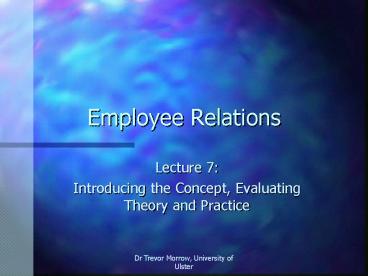Employee Relations - PowerPoint PPT Presentation
1 / 12
Title: Employee Relations
1
Employee Relations
- Lecture 7
- Introducing the Concept, Evaluating Theory and
Practice
2
Introduction
- Defining Employee Relations Employee relations
encompasses a set of phenomena, both inside and
outside the workplace, concerned with determining
and regulating the employment relationship
Salaman 2000 - Perspectives on Employee Relations
- 1) Unitary 2) Pluralist 3) Marxist
3
Defining Employee Relations
- Strategic hum resourcing options in
management-union relations - 1) Non-Union 2) Single Union 3) Multiple Unions
- Internal Factors
- Size of the Organisation, ownership and location,
- management philosophy
- External Factors
- Union Power and Legislation
4
The Changing Landscape
- 1) Sophisticated Human Relations
- 2) Paternalism
- 3)Traditional
- 4) Sophisticated Consultative
- 5) Modern Paternalism
- 6) Bargained Constitutional
5
Changing Patterns in union membership and
collective bargaining
- Why do people join trade unions?
- Changing Levels of Trade Union Membership
- High Point 1979 453 Unions, 13. 2 million
- members, 50 of working population,
- 57 Trade union Density
- Low Point 1998 238 Unions, 7.85 million
- members, 29 of working population, 27
- Trade union Density
6
The Changing Nature of Employee Relations
- The Changing Nature of Employee Relations
- 1) Input-Output Model
- 2) Industrial Relations System (Dunlop 1958)
- 3) Social Action
- 4) Control of the Labour Process
- 5) Human Resource Management
- 6) Social Partnership
7
Aspects of Employee Relations
- The Rule Making Process Rules for governing
employment, and the ways in which the rules are
changed, interpreted and administered - Levels of Analysis
- Four main levels 1) Workplace 2) Organisation
- 3) Industry or National Level 4) Societal Level
- Industrial Relations issues Two distinct types
of issues - 1) Substantive Issues
- 2) Procedural Issues
8
Employee Relations The Complexities in Context
- The links between employee relations and the
labour market - Levels and Distribution of Pay, Demand and Supply
of Labour, Level, Structure and Distribution of
Employment, Government Regulation/Intervention,
Economic Cycles, Demographic Factors,
Technological advances, Expectations
9
The Parties to Employment Relations An Overview
- Management and Employers
- The Traditional Management Function,
Sophisticated - Management Function, Human Resource Management
- Management Organisations Employers Associations,
CBI, - Employee Organisations, Trade Unions, TUC,
Professional bodies, - The State and State Agencies, Employment
Tribunals, LRA/LRC etc
10
A Brief History of Employee Relations in the UK I
- Nineteenth Century Development Growth of Trade
Unions, Legalisation of Trade Unions in 1825 - Twentieth Century Development National and
Industry Level Collective Bargaining, Economic
Depression, High Unemployment, Decrease in TU
membership, hostile employers - Increased pressure on post-war industrial
relations employee pressures, employer pressures
11
A Brief History of Employee Relations in the UK II
- The Donovan Commision (1968) The Transformation
of Collective Bargaining, Voluntary Reform - 1976-1980- Confrontation
- 1980- Government Legislation and Intervention
- 1980s New Realism Changing roles for
management, Process relationships, collective
bargaining - 1990s- New Industrial Relations/Social
Partnership
12
Summary
- The Importance of Theory and Practice
- Differing Stakeholder Views
- Constant Evolution and Change
- Labour Market Transformation
- New Management Theories
- National and International Systems
- Simplicity and Complexity































